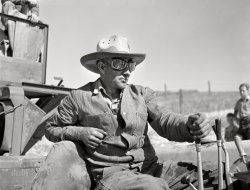
MAY CONTAIN NUTS

Search Shorpy
SHORPY ART

Framed or unframed, desk size to sofa size, printed by us in Arizona and Alabama since 2007. Explore now.
Join and Share
Ad-Free Shorpy
Shorpy is funded by you. Patreon contributors get an ad-free experience.
Learn more.

Recent comments
- Details, Details
- What's that building to the left of the tower?
- Coal Barges
- Bromo-Seltzer
- Inner harbor
- The Basin
- What a headache!
- Giant stepladder?
- Baldwin 62303
- Baldwin VO-1000
- Cold
- No expense spared
- Tough Guys
- Lost in Toyland
- And without gloves
- If I were a blindfolded time traveler
- Smoke Consumer Also Cooks
- Oh that stove!
- Possibly still there?
- What?!?
- $100 Reward
- Freeze Frame
- Texas Flyer wanted
- Just a Year Too Soon
- WWII -- Replacing men with women at the railroad crossing.
- Yes, Icing
- You kids drive me nuts!
- NOT An Easy Job
- I wonder
- Just add window boxes
Member Photos
The Shorpy
Print Emporium
Print Emporium
Search Shorpy
Search results -- 30 results per page
- Dacotah: 1940
- ... Dakota." 35mm nitrate negative by John Vachon for the Farm Security Administration. View full size.
It's all very different ... Posted by Dave - 12/09/2011 - 11:27am -
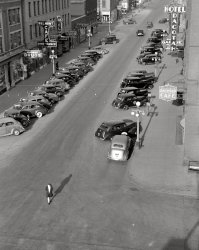
- Real [Blank] Spaghetti: 1940
- ... been painted over. 35mm negative by John Vachon for the Farm Security Administration. View full size.
You might think all spaghetti ... Posted by Dave - 11/20/2011 - 6:30am -
![Real [Blank] Spaghetti: 1940 November 1940. "Greek restaurant in Paris, Kentucky." Mussolini's Fascist regime has just invaded Greece, and the word ITALIAN has been painted over. 35mm negative by John Vachon for the Farm Security Administration. View full size.
You might think all spaghetti was ItalianBut my ex mother-in-law made spaghetti sauce using Campbell's tomato soup with Velveeta cheese and bologna. This was circa 1955 in Lexington. Kentucky was and is nice (I went to U of Ky), but Connecticut is better for Italian food.
First we stop at Nick'sfor a plate of unknown spaghetti, then next door to pick up a new Chevy.
Real Spaghetti SandwichesYum! I bet those are good sandwiches. After lunch I think will go and buy a Hevrolet.
Axis powerWhy would they black out "Italian." Perhaps it has something to do with the run-up to WWII.
[Perhaps it was WWII itself, and the caption explains it. - Dave]
Childhood RhymeWhistle while you work,
Hitler is a jerk,
Mussolini
Is a meanie,
Whistle while you work.
As for the "real spaghetti sandwiches," we actually had a kid in our class who brought those from home for lunch as most families had little meat. Also sardine sandwiches, plain mayonnaise sandwiches, etc. I kind of like going back to the 40's since even after 70+ years I still remember those friends and conversations. I have read that your childhood friendships were the real thing because little kids have not developed the phoniness, social obligations, artificiality or opportunism persona, but accept each other at face value. I miss my old friends, but I digress, I'll shut up now.
LSMFT in the '40s"Lucky Strike Means Fine Tobacco." It also could mean "Lord Save Me From Truman." Heard it both ways many times in the late '40s and early '50s.
No Italian spoken hereMy stepsister, who was Icelandic, spoke Italian. We lived in the U.S. from 1941 to 1944, when she was 7-9 years old, but she refused to utter a word in that language. I only spoke Icelandic and Danish, so I didn't have that problem.
I wish I still had my Hitler button. It had a string that brought Der Führer up with a noose around his neck when you pulled it. It was an interesting time for us kids, totally oblivious of the horrors of war, although we saw saw some action in October of 1941, when the convoy we were a part of was attacked by German subs. We didn't get hit, but we saw the Reuben James get it. Woody Guthrie wrote a song about that historic sinking.
Eating for successI know it is not the intent of the sign, however, I have had spaghetti sandwiches even recently. Best eaten on an Italian roll with smashed meat balls, a good sauce and sprinkled cheese. During the Depression, my mother took baked bean sandwiches to school. Other kids made fun, so she told them she loved baked beans so much that she asked her mother to make her lunch with them. Somehow, even hungry, the kids made it through and obtained a fine education. Now the kids get free school lunches - complain about them, and get lower test scores than ever. There must be a moral to learn there somewhere.
Rue Principale, Paris (KY)Nick's is now Charles' Barber Shop, and the Chevy dealership is an antique mall.
View Larger Map
Couldn't resist!Love the juxtaposition of old and new!
Mayo clinicNothing wrong with eating cheaply, so long as you're eating. When my dad was a student at University of Florida in the 1950s, his budget allowed him to eat mostly mayonnaise sandwiches. He never complained that he despised it though -- he still loves mayonnaise to this day.
(The Gallery, John Vachon, WW2)](https://www.shorpy.com/files/images/SHORPY_8a32712a.thumbnail.jpg)
- In the Shop: 1939
- ... Georgia." Acetate negative by Marion Post Wolcott for the Farm Security Administration. View full size.
Look the other way! The ... Posted by Dave - 04/29/2019 - 3:50pm -
![In the Shop: 1939 May 1939. "Repairing automobile motor at the FSA warehouse depot in Atlanta, Georgia." Acetate negative by Marion Post Wolcott for the Farm Security Administration. View full size.
Look the other way!The engine stand is fully rotatable and adaptable to the crazy variety of engines around then!
The Ford there is set up here to rotate around 90 degrees to the center of its axis, but since it is a very compact engine it could also attach 90 degrees to that and rotate on its crank axis. The big crank handle and gear motivate the rotation, and the two rails beside the engine hold the engine. This general sort of engine stand was supplied with a large variety of brackets to directly fit popular engines to the rails.
It had to be able to accept huge variations in length, shape and weight. There were nearly all the shapes we have now, large straight sixes, lots of straight eights, and, almost unbelievably, Cadillac made V-16's through 1940.
The long ramp leading up to the mechanic's feet provided the space needed to hold at least most of these, from flat-two Crosleys up to the 16's.
Tired engineRemember that most roads in the USA in 1937-39 and well after were dirt, maybe dirt and gravel and if in a really well off county they were dirt, gravel with a generous (sometimes) cover of heated tar. And I am pretty sure that an oil bath air filter was standard on all cars meaning copious amounts of dust made its way to the combustion chamber and the the cylinder walls making a great oil and grit very fine scrubbing compound to eat away cylinders. In this case the mechanic is probably only replacing the oil rings on the pistons. Next tear down the heads come off and the cylinders get a 20, 30 or maybe even a 60 thousandths bore, new pistons and rings, at a minimum.
Not the one the revenuers use I see the MayPops are mounted on the front wheels this time. Wouldn't want to go driving around North Georgia on those tires. Too many curves, hills, frog drowner rainstorms, and the dropoff past the berm on most roads is still pretty steep.
Appears that the FSA didn't have a laundry contract for coveralls. That one could likely stand up in the corner when doffed.
TiredNice Maypop Onionskin on the front passenger side. And the driver's side not much better.
Under the hoodI think I see the Shroud Of Atlanta, or maybe the Hood of Atlanta.
Overhaul already?That 221 cubic inch flathead V8 is being pulled from a car that's only two years old.
Also interesting to see that the Department of Agriculture had their own fleet maintenance in those days. That has been the purview of the GSA for decades now.
Two yearsI drive a 2006 car and change the oil every 3,000 miles (5,000 km here in Canada), but I don’t even bother checking the oil in between visits to the garage. Here is an engine getting yanked for repair after only two years, while my little yellow engine light went on, just the other day, for the first time ever, after 13 years.
They don't build em like that any more!That car is at most two years old and already needs engine repairs, the rest of it looks rather beat as well.
Granted it's a Dept of Agriculture vehicle so it probably spent a lot of its time on dirt roads.
The mystery of the pistonsRight where the photo turns to blur for my eyes, I think I see a bare cylinder head stud sticking up at the front of the left head. He may just be doing the sides separately, and the right bank is completed or not yet begun. There are certainly no more than four pistons on the bench. The left head is in place, with my guess being that the photographer requested symmetry and less jagged detail right there, and they dropped it back on its studs to make him happy!!
[The him was a her, and I doubt it. - Dave]
Tired tiresDefinitely not safe at any speed.
Re-ring and bearing job?There's a lot going on here. I see pistons and connecting rods laying on the bench, which makes me think he's replacing piston rings along with rod and crankshaft main bearings. But, the cylinder heads are still on, and I see the nose of the crank sticking out of the front of the block, at the bottom. I'm no flathead Ford expert, but I know that with some engines you can pull the pistons out through the bottom of the cylinders (so you don't have to pull the heads), but I don't imagine it would be easy to get them back in that way, with a ring compressor on them.
I've never seen an engine stand like that - I'm used to the type where you bolt a fixture to the back of the block using the bellhousing bolt holes, with the fixture having a sleeve on the back that fits in a socket on the stand, allowing you to rotate the engine around to get to the oil pan, crank, rods, etc. This one just doesn't look practical.
I also see that the dust cap is missing from the right front brake drum, and the spindle nut with cotter pin are exposed. This will eventually allow dirt, grit, and water into the wheel bearings, causing an early failure.
The right front tire is an Allstate, a brand sold for many years by Sears, along with Allstate-branded batteries and other items. The battery is a Firestone, so it looks like they spread the business around (or it's just expediency, for a car used out in the field, traveling through small towns).
More than just automobile enginesare being repaired here. I see a stationary engine next to the wall with the head removed and a repair tag. I can't tell what type it is, but the cooling hopper has an extension added to hold more water.
(The Gallery, Atlanta, Cars, Trucks, Buses, M.P. Wolcott)](https://www.shorpy.com/files/images/SHORPY-8c09946a.thumbnail.jpg)
- After Taxes: 1939
- ... newspapers of the term 'concentration camps' referring to Farm Security Administration camps." Medium format nitrate negative by Russell Lee ... Posted by Dave - 09/09/2011 - 6:44pm -
![After Taxes: 1939 February 1939. "White mother with children at migrant camp. Weslaco, Texas." Background for this series of photos as recorded by Russell Lee in his notes: "Local employment men say that there was no need for migrant labor to handle the citrus and vegetable crops in the valley, the local supply of labor being ample for this purpose. Most of the local labor is Mexican and the labor contractors favor Mexican labor over white labor, partly because the Mexican will work much cheaper than whites. One white woman who was a permanent resident said that the white people who lived in the valley had no trouble with the Mexicans. The Mexicans were good neighbors, she said, always willing to share what they had. She said the white migrants who came into the valley and resented and misunderstood the Mexicans caused the trouble between the two races. Some towns in this section permit camping only in trailers. The charge for camping in tents is about fifty cents per week, including water, which in some cases must be carried four city blocks. Privies are tin, very bad condition. Garbage is collected only once a week, with large dumps of decaying fruits and vegetables scattered among the camps. Some of the white migrants in this camp were very suspicious of governmental activity, due to the use by south Texas newspapers of the term 'concentration camps' referring to Farm Security Administration camps." Medium format nitrate negative by Russell Lee for the FSA. View full size.
Seventy years agoThat's really not such a long time. I wonder how well we're going to handle the next economic rough patch? Who will be taking the pictures this time?
todayI WISH SOMEONE WOULD PUT THIS ON THE NET...I DONT KNOW HOW ... WITH THE CAPTION..THIS IS IN OUR FUTURE IF
WE CONTINUE TO NOT TALK ABOU THE ELEPAHNT IN THE LIVING ROOM.
[The "elepahnt," oddly enough, has no problem talking about crazy all-caps guy. - Dave]
Russell Lee's commentsI found Russell Lee's background comments to be fascinating. I guess even back in the 1930's labor was an issue between immigrants (illegal or legal, who knows?) and migrants from the Dust Bowl days. The faces of the mother and children tell stories of their own, don't they?
Reading MaterialThere's a book/magazine/catalog to the left behind the baby child I can't make out. Would love to know what it is/its travels.
[It's a Chesterfield cigarette ad on the back of a magazine. - Dave]
ClassThrough all her obvious hard times this lady maintains a look of dignity with her beautiful children.I hope they all had happy lives.
(The Gallery, Agriculture, Great Depression, Kids, Russell Lee)](https://www.shorpy.com/files/images/8b37154u.thumbnail.jpg)
- Purr Me Another: 1937
- ... Craigville, Minnesota." Photo by Russell Lee for the Farm Security Administration. View full size.
Rough With The Smooth So ... Posted by Dave - 02/23/2018 - 5:24pm -
![Purr Me Another: 1937 September 1937. "Lumberjack at the bar on Saturday night. Craigville, Minnesota." Photo by Russell Lee for the Farm Security Administration. View full size.
Rough With The SmoothSo goes the story of a lumberjack who,
Brought his kitty into the bar bearing life's heavy load
Without a thought for himself, did with a sigh say,
"I'll have one for my baby, and one more for the road"
Ohhh I'm a lumberjack!And I'm OK.
I sleep all night and I work all day.
I cut down trees. I skip and jump.
I like to press wild flowers.
On Wednesday I pet kitties
That hang around in bars.
Long Branch saloon?Well, there's Miss Kitty.
This picture is incredibly sadI've sat here staring at it for ten minutes, trying to come up with a backstory that isn't totally depressing and tearjerking, and utterly failed.
[Spilled milk? - Dave]
Looks familiarI would not be surprised if that man is me in a past life.
Drinks, please!I'd like a "Catster", and for my little buddy, a "Hair of the Dog".
Deja vuBeen there, done that. (several times but without the cat).
SadThis picture almost makes me cry. And I'm 65 years old.
At leastHe has a job during the Great Depression, spotlessly clean hands, a full head of wavy hair and the friendship of a nice little cat. So there is hope for the lumberjack that he went on to enjoy better days.
HauntingLong time lurker here, but had to reg just to comment on this image; like others here this has haunted me. It is incredibly sad.
My photo class in college introduced me to the pics in The Family of Man - nothing in there was as profound as this.
Why hasn't this image captured all the available awards? Sarting with the Pulitzer & not stopping.
Although I have a professional printer which I use to print my art, I'm ordering a print as a Thank You for finding this image.
HauntingI enjoy coming to the site every couple weeks and reviewing old photos. Shorpy is a wonderful contribution to the internet.
Like previous commenters, this one stopped me in my tracks. What a intimate and revealing photograph, and what an incredible moment that was captured.
In a time when twitter posts about what is trending with a hashtag drive a newscycle, this photo, by comparison, arrests the mind of the viewer and depicts a shard of the man's soul.
Best, by fur!I nominate the title given to this photo as the "Most Clever" of the many Shorpy titles.
(The Gallery, Cats, Russell Lee)](https://www.shorpy.com/files/images/SHORPY-8b19906a1.thumbnail.jpg)
- Mosquito Crossing: 1939
- ... format acetate negative by Marion Post Wolcott for the Farm Security Administration. View full size.
Which one? The place name ... Posted by Dave - 04/21/2021 - 11:52am -
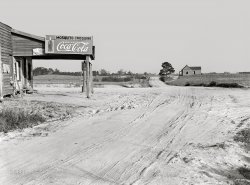
- Granitine: 1942
- February 1942. "Burlington, Iowa. Acres Unit, Farm Security Administration trailer camp. In the utility building for workers at ... Posted by Dave - 08/16/2021 - 9:56am -
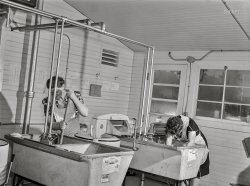
- Grit n Coke: 1938
- May 1938. Farm boy who sells "Grit." Irwinville Farms, Georgia. View full size. 35mm nitrate negative by John Vachon for the Farm Security Administration.
Grit info http://www.grit.com/
[Grit, which ... Posted by Dave - 07/05/2009 - 2:34am -
![Grit n Coke: 1938 May 1938. Farm boy who sells "Grit." Irwinville Farms, Georgia. View full size. 35mm nitrate negative by John Vachon for the Farm Security Administration.
Grit infohttp://www.grit.com/
[Grit, which started out as one of the first nationally distributed newspapers, is now a glossy bimonthly magazine. Lead article: "Why Are Barns Red?" - Dave]
Grit RingtonesI think I remember comic book ads about selling Grit. Dave, you have to check out the ringtones, priceless.
[Hmm. I'm torn between "Tractor in Reverse" and "Tractor Idling." - Dave]
Grit MemoryI think the first time I saw a Grit ad was in Boys Life. The Boy Scout magazine
Of minor noteYou'll see that the sign for Dr Pepper contains a period after the "Dr", an abbreviation indicator they later dropped for typographical reasons.
Store in BackgroundMy Grandfather, John C. Miller, ran the only store in Irwinville Farms (Georgia) during the depression. I'm pretty sure this is the store behind the young boy.
[In addition to the store above, which was a farmers' cooperative (another view below), the archives show this small grocery. - Dave]
Now PlayingAccording to the poster in the window, the following movies from 1938 are showing at the local theater:
Go Chase Yourself
Joe Penner & Lucille Ball
In Old Chicago
Tyrone Power & Don Ameche
Mr. Moto's Gamble
Peter Lorre & Keye Luke
Merrily We Live
Constance Bennett & Brian Aherne
Rawhide
Smith Bellew & Baseball's Lou Gehrig
(The Gallery, Great Depression, John Vachon, Kids, Rural America)](https://www.shorpy.com/files/images/8a03421u.thumbnail.jpg)
- Smokes-N-Cokes: 1939
- ... Medium format negative by Marion Post Wolcott for the Farm Security Administration. View full size.
Injury Update Two of our ... Posted by Dave - 04/18/2019 - 11:56pm -
![Smokes-N-Cokes: 1939 September 1939. "Students on steps of building between classes. University of North Carolina, Chapel Hill, Orange County." Medium format negative by Marion Post Wolcott for the Farm Security Administration. View full size.
Injury UpdateTwo of our seated smokers appear to have injuries: one to the right hand, and the other to the left foot.
Battered and bruisedLooks like Chester's foot is messed up (and he's got crutches), and Skippy's finger is in a splint! Okay, time to come up with a good story; after all, there's a girl here to impress!
A snazzier time.It's interesting to see students at college dressed a lot nicer than they dress nowadays. When I was in college in the early 00s, it was nothing to see someone roll into class, still in their pajamas. I never did that, but I'm guilty of having worn sweatpants/lounge pants more than jeans or something dressier. I certainly never saw any male student in a suit and tie. You were lucky to find a guy in a t-shirt that didn't have a food stain on it!
Accident Prone?One guy has a broken finger and another has his foot in a cast. Also, everyone has a cigarette in their hand except for the guy sitting on the steps, but that is only because we can't see if he has one too.
Walking WoundedThis is a tuff school. One guy is on crutches with a cast on his left foot. The guy to his right has a broken finger. I wonder what's wrong with the rest of them?
Most of the guys I knewwould dress in jeans, a sport coat or cardigan sweater and a thin tie, popular then in the early '60s. We always dressed that way and no one that I can remember came to our Junior College looking like a slob or so casual that it bordered on disrespect for the college and classmates. If I were in college today I would still dress that way to show that I appreciate where I am and the education I was receiving. But that's just me.
[If you were in college today, you'd do what you did 55 years ago -- dress the way your friends do. - Dave]
Hope they quit that terrible addiction of smokingA friend of mine used to say the exact same thing. "Coke and a Smoke."
Had a massive coronary at 67. Smokes are finished. Still has a Coke now and then.
Tough classes in college Careful on those steps. Crutches, foot in cast, and finger in splint. Jeez!
The lost art of conversationToday, they'd all be texting.
I'm 40 years younger than these students and 40 years older than the students of today. I suspect that I would have more in common with the students of 1939.
I'll be buried in 'emFlorsheim Kenmoor wingtips. You can still buy them and they last a lifetime.
Classic CokeAhhh!! Ice cold Coca-Cola in a glass bottle right out of the machine. 5 cents for 6 ounces at the gas station next to my house in the '50s and '60s. Made with cane sugar, not corn syrup. I can get still the "Real Thing" with sugar, made in Mexico, at my local supermarket. Takes me back!
Banged UpI notice a broken finger on one guy and a cast on the left foot of the other. I wonder if we're looking at a couple of members of their football team, which was pretty good (8-1-1) that year.
My dad vividly remembers the old days of university attire, especially a guy who washed his dark gray slacks with his towels. He joked that he had all semester to clean the lint off. (Moms, teach your sons to do laundry!)
Jocks and Bobby SocksI also believe the injured guys are school athletes. My father was of this generation and said back then boxing was the only sport in which smoking was discouraged.
Fast forward to the early 1970s when I played high school football: the coach issued a list of possible infractions for team members and the corresponding punishments (if caught). I found the list a couple of years ago as I purged things I no longer need. What stood out to me in these modern times is that the punishment for smoking was far less severe than the punishment for swearing.
Let the games begin.Big stairs with ledges beside them, smooth columns... the steps don't quite match Morehead Planetarium or Manning Hall, Gardner is missing the columns, Wilson Library has fluted columns, and Carroll wasn't built until 1955.
I am thinking it's a building that no longer exists.
[It's the UNC South Building. Still very much there. - Dave]
Edit: I figured it was one of the older ones, but couldn't make it downtown to confirm on a weekend. Thanks!
(The Gallery, Education, Schools, M.P. Wolcott)](https://www.shorpy.com/files/images/SHORPY-8c11122a.thumbnail.jpg)
- Bleak House: 1940
- ... Medium format acetate negative by John Vachon for the Farm Security Administration. View full size.
Pipe dream. I’ve always ... Posted by Dave - 12/18/2019 - 10:54am -
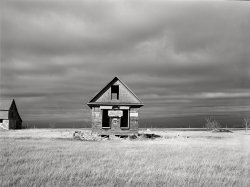
- Baby Sitting: 1939
- ... let us know! 35mm nitrate negative by John Vachon for the Farm Security Administration. View full size.
IT'S NOT ME Thought ... Posted by Dave - 05/17/2011 - 3:54pm -
![Baby Sitting: 1939 September 1939. "Untitled." If this is you, please let us know! 35mm nitrate negative by John Vachon for the Farm Security Administration. View full size.
IT'S NOT METhought I'd let you know.
Reduces the number of possibilities by one.
NormallyOne could expect the guys to holler, "IT'S NOT MINE!" They suppose the 70+ years exempt them.
This child looks to be a few months older than my mother-in-law. She's still with us. Both the subject and its mother may be, too.
Narrowing it downThe rest of Vachon's September 1939 photos in the LOC archives are from three resettlement administration project sites in Wisconsin (in Greendale, Vernon County and Dane County), and industrial sites in Minneapolis. Based on those photos, my money is on Greendale.
[More than those three. Baby's neighbors in the archive are a Vachon photo dated September 1939 snapped in Washington, D.C., at Union Station, and another taken in Milwaukee. - Dave]
Pinned DownInteresting technique - pinning the shirt to the diaper. Probably very common, but I never thought of it before.
Clear EyesWhat a stunning, clear-eyed baby!
Obviously well-cared for, happy and healthy.
It's not me eitherI looked so much like a chimpanzee that people were forever offering my mom a banana for her "little one."
(The Gallery, John Vachon, Kids)](https://www.shorpy.com/files/images/8a04360a.thumbnail.jpg)
- Chillycothe: 1940
- ... home from school." 35mm negative by John Vachon for the Farm Security Administration. View full size.
A rare sight indeed Kids ... Posted by Dave - 11/29/2011 - 4:01pm -
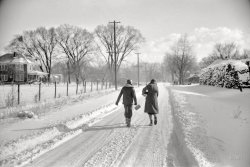
- The Piney Hotel: 1941
- ... format acetate negative by Marion Post Wolcott for the Farm Security Administration. View full size.
GM Territory "Five out of ... Posted by Dave - 04/16/2021 - 1:56pm -
![The Piney Hotel: 1941 September 1941. "Hotel in Big Piney, Wyoming." Last glimpsed here. Medium format acetate negative by Marion Post Wolcott for the Farm Security Administration. View full size.
GM Territory"Five out of Five"
From left to right: 1941 Chevy Master Deluxe, 1938 Chevy Half Ton, 1941 Chevy Master Deluxe Coupe, 1929 Pontiac Coupe, 1940 or 1941? Chevy Master Deluxe.
"No hats allowed in bar"Was it a thing during the depression to leave one's hat outside a bar?
Or, was it just so windy that men's hats randomly blew off their heads and landed on benches and cars?
Wrong HatThis one is just before the one with the cranky guy. The hat on the bench is the same, but the dog is still on his way (he's in front of the car near the cafe door). Don't see the cranky guy but somebody is emerging to the left of the hotel building in a dark hat. The pickup is already there.
[You missed a hat. Cranky Guy is standing next to the dog. - Dave]
Yup--I see it now ...
Quick exitAsk for our special suite with Express Checkout.
They did not oversell their productThe Piney Hotel, Café, & Bar were a good place to stop; just read their sign.
Not a great place.
Not the best place.
Not the only place (although I suspect it may have been).
Just a good place ... plus it's right in front of you.
I wouldn't change it.
New Frontier Hardware & HotelA slightly different name and appearance today:
Camp Big PineyThere's a sign for Camp Big Piney outside the hotel. The camp was run by the Civilian Conservation Corps. It was a spike or satellite camp for Camp Fremont, one of the first CCC camps. When this photo was taken in September, 1941, the camp was starting to close down for the winter. It didn't reopen in 1942 - many of the CCC recruits joined the armed forces. It looks bleak:
The Hotel TaleAccording to "Wyoming Tales and Trails", The hotel was constructed by Franklin Daniel Chapel (1873-1942). Chapel moved to Big Piney about 1912 and purchased the "Bucket of Blood" saloon from Floyd Norris, he then constructed the hotel. As can be seen from the attached photo and from second floor door, the hotel originally had a second floor porch which wrapped partially about the building.
The building to the left of the hotel with the BAR sign was the "Bucket of Blood," commonly called the "Bucket." The hotel was famous for its mountain trout.
The hotel, the Bucket, the city hall and jail all burned in August 1948. Several occupants of rooms on the second floor of the hotel were rescued by stockman and rodeo cowboy Ross Meeks.
Watch That First Step"Hey, who removed the balcony?", asked the man from his hospital bed.
See if You Can Guess— after taking a nice long look at it, why the Big Piney Hotel only lasted a few more years after this photo was taken. I'll wait.
(The Gallery, Dogs, Frontier Life, M.P. Wolcott)](https://www.shorpy.com/files/images/SHORPY-8c15894a.thumbnail.jpg)
- Square Dance: 1939
- ... County, Oklahoma. Photograph by Russell Lee for the Farm Security Administration Office of War Information circa 1939. View full size. ... Posted by Ken - 09/08/2011 - 6:35pm -
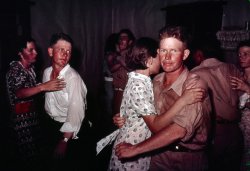
- Modern Beauty: 1942
- ... Ress Court . Acetate negative by John Vachon for the Farm Security Administration. View full size.
Hmmm. My idea of beauty ... Posted by Dave - 02/12/2022 - 11:08pm -
![Modern Beauty: 1942 April 1942. "Missoula, Montana. Tourist apartments." The "Strictly Modern" Beauty Ress Court. Acetate negative by John Vachon for the Farm Security Administration. View full size.
Hmmm.My idea of beauty lies elsewhere.
For sureBeautiful photograph of an ugly building.
Modern mysteriesSome of the things in this picture I understand, others I don’t. Stuff I get: The benches under the windows are for sitting outside your motel room, to observe and smoke and ponder. The gravel courtyard is for making that crunchy sound under the car tires. The wooden screen door is for the slamming-shut sound. But why waste good interior space for a carport? Motel parking is always outdoors – you pull up in front of your door, there’s no garage. And why so many arched pass-throughs to the other side – one per room? And what is the function of those punctuation marks after the word Modern? I am content to stare at this image with passive enjoyment (I find it calming), but then these issues disturb the peace and make me begin to wonder why this, why that.
[Carports: Montana winters. - Dave]
Dave: I come from Manitoba winters where carports aren’t a thing – you need a garage with a garage door or you park outside.
[These are garages without doors. And not in Manitoba, either. - Dave]
Just my point: if you want a garage for the winter part of car ownership, a carport won’t do in places like this. If the garage doesn’t have a door, you’ll be doing a lot of wind-related shoveling, whether in Montana or Manitoba.
JennyPennifer: I figure those bedsprings are to keep the front bumper of the car away from the wall.
DittoTo everything davidk said (I pondered for several minutes on the characters after the word MODERN), but one final question (tongue firmly in cheek): Why the bedsprings at the back of two of the garages (and, for all I know, the third one)? Surely too cold to sleep out there in a Montana winter -- especially without a mattress and at least one blanket.
Bed frames and carportsIt was common to get a room and for a fee, add on an extra twin bed for the kiddies (or maybe Aunt Edna).
The carports seemed to me to be mainly a luxury feature they could tout on billboards.
I remember both things from our family vacations as a tyke.
(The Gallery, John Vachon, Small Towns)](https://www.shorpy.com/files/images/SHORPY-8c22030a.thumbnail.jpg)
- In My Room: 1941
- ... Medium format acetate negative by John Vachon for the Farm Security Administration. View full size.
The everyday world I like ... Posted by Dave - 02/26/2020 - 8:01pm -
![In My Room: 1941 June 1941. "Untitled (Hotel room, Milwaukee, Wisconsin)." Medium format acetate negative by John Vachon for the Farm Security Administration. View full size.
The everyday worldI like some of these photos by Vachon - no drama. no pathos, no unusual point to be made, just a document showing how things were and what they were. The "stick" telephone, the sink, the style of furniture, all these give a feeling of the time and place.
The Hotel WisconsinA July 5, 1941 letter to Vachon from FSA's Roy Stryker indicates Vachon was staying in the Hotel Wisconsin on this visit. That 500-room hotel, constructed in downtown Milwaukee in 1913, survives today as a renovated apartment building.
Chicken wireIs that what was used for a screen? Can't imagine it would keep too many insects out!
[Zero chickens here, so it must work. - Dave]
That ashtrayDAMN that's a big ashtray. I assume that's what the flat glass object on the dresser is.
High-capacity, perhaps, as a safety measure, to reduce the frequency with which it would be dumped into the trash, with the attendant fire risk?
Signs of the TimesI love the placement of the faucet spout. So high up the wall. It would be great for washing your hair. Although the splashing from so high up could be messy.
With his wallet out and so close to the pillow, do you think this could have been for police evidence? Taken just after his room was broken into?
And a soon to be a vanishing relic from the past. The telephone book. It was such a basic necessity back in the day. Now you can hardly find one.
Dang I love this site. Thanks guys.
Welcome to the Hotel WisconsinLooks like John Vachon is staying at the Hotel Wisconsin, which is now the Grand Wisconsin Apartments. The view is looking east toward Waldheim's Furniture, and that building also still exists.
ChickenwireThe chickenwire was embedded in the glass to prevent it from shattering. Used to be quite common.
Re: Chicken wireI think that is that kind of glass they used to have in old schools that had wire embedded in it to keep it from shattering.
re: Chicken WireLooks like a kind of safety glass. It had 'chicken wire' embedded in it. My grade school had this in all the ground floor windows and doors.
Nothing missingSteam heat, operable window with shade and drapes, dresser with mirror, ashtray the size of a wading pool, comfy bed, Ameche with directory, nightstand with lamp, sink for morning wash & brush-up, mystery ellipse on floor under sink, wallpaper that won't keep you up at night. Wisconsin was a home game for the Gideons, so that is certainly covered also.
All you could expect of a downtown hotel room in 1941. I'm guessing that it's about a $5 room.
700 Block of North Plankinton AvenueI don't think the hotel is still there, but the building across the street still is. It is the old Waldheim's Furniture Building. Now loft condos.
https://www.wisconsinhistory.org/Records/Image/IM47664
https://www.corleyrealestate.com/idx/listings/river-front-lofts/
Where's the Beer?I guess some things are best kept out of sight.
re: Chicken WireThe wire mesh glass is more fire-resistant than regular glass (but less tough). And Shorpyites know all about hotels and fires...
(The Gallery, Cars, Trucks, Buses, John Vachon, Milwaukee)](https://www.shorpy.com/files/images/SHORPY-8c19667a.thumbnail.jpg)
- Lewiston Hill: 1941
- ... of Lewiston." Acetate negative by Russell Lee for the Farm Security Administration. View full size.
Nice view from a motel ... Posted by Dave - 02/10/2022 - 11:54am -
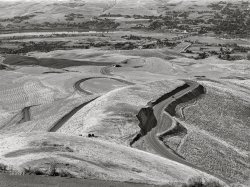
- Wreck on the Highway: 1939
- ... near Iowa Falls, Iowa." Photo by Arthur Rothstein for the Farm Security Administration. View full size.
Death on the Highway Victim ... Posted by Dave - 02/16/2018 - 11:26pm -
![Wreck on the Highway: 1939 September 1939. "Accident on U.S. Highway 65 near Iowa Falls, Iowa." Photo by Arthur Rothstein for the Farm Security Administration. View full size.
Death on the Highway VictimWatching this film in the 70's during drivers education class there was a rumble and clank from the back of the room. A girl had fainted while watching and hit her head on a radiator. She was OK.
Chest crush injuryThe bent-in steering wheel on the Dodge tells the tale of a classic injury producer in the days before collapsible steering columns. The steering box, and, in turn, the column and wheel, were pushed back at the same time the driver's body was traveling forward at a rapid rate. My guess is that the driver has rather more than a few broken ribs... if, indeed, he lived.
Those Driver Ed. High School FilmsIn the mid 60's those blood and guts car wreck films in glorious color all seemed to come from the Ohio State Highway Patrol. My high school showed them during assembly. As bad as they were the lung removal film from an OR to keep kids from smoking was even worse.
Steering Wheel TriadFolks who had a misspent youth doing shifts in an Emergency Room adjacent to a major highway in days before the adoption of seat belts, airbags, crumple zones, and collapsible steering columns learned about the triad of: multiple rib fractures, laceration of the liver, and fractures of both femurs as the driver moved up and forward rapidly decelerating against a steering wheel moving in the opposite direction. Those were not the good old days.
Onlooking/gawking EtiquetteREQUIREMENTS: 1], be male; 2], be willing to mingle in groups of three or more and hover close as possible to action; 3], if wearing cap or hat, must be at tilt to one side, or pushed up from back; 4], one arm across stomach with other extended up with as fist fashion with thumb supporting chin, or, arms be folded across chest; opts: both hands in front pockets, both hands on hips, or, if hands behind back must be connected in hook fashion by both forefingers; 5], must share expertise and sage advise with fellow onlookers; 6], refrain from conversing or offering advice to officials at scene; 7], remember sufficient graphic details in order to share with one's spouse upon arriving home.
No Winner TodayThere seems to be a tie between the 35 Plymouth and the 38 Ford. Both are, likely, headed for the last roundup
Re: Driver's Ed.Although they were only animated, the shorts from the late fifties, narrated by Fletcher Pratt and produced by the Ford Motor Co. were a lot like those. They showed a real accident in animation and then went to describe who was a fault and why.
Texting No DoubtBack in the days when cell phones had cranks on the side.
I always hated to see pushed up steering columns and bent up steering wheels like we see in that Plymouth. You know that HAD to hurt!
FatalHaving been an accident investigator, this was most probably a fatal accident. Note that the steering wheel has been pushed back, then up. The steering wheel rim has been pushed down around the steering column (death grip), allowing the column to act like a spear. Unfortunately, padded dashes and seat belts are years away.
Driver's Ed.This brings back memories of the "safety" films we had to watch in my Driver's Education classes back in Texas in the mid-'60s. The running theme in these films seems to have been to scare us into driving safely. One of the more infamous as "Death on the Highway", filled with scenes like this and images shot before the ambulance and hearse staff finished.
[“Signal 30" was the one that traumatized me. -tterrace]
Re: Those Driver Ed. High School FilmsThe reason you see the Ohio State Highway Patrol so much in these films was that the organization that made them, the Highway Safety Foundation was located in my hometown of Mansfield, Ohio. This now-defunct group had a bit of a checkered past. Read this.
Always thinOne thing evident in all these old pix, an overweight person is few and far between, and those that do look heavy also look extremely strong. In the circus or fair side shows in this era, the average weight of the 'Fat Lady' was 220 pounds. Now, that seems to be the national average.
(The Gallery, Arthur Rothstein, Cars, Trucks, Buses)](https://www.shorpy.com/files/images/SHORPY-8b18338a.thumbnail.jpg)
- The Last Roundup: 1941
- ... Medium format acetate negative by John Vachon for the Farm Security Administration. View full size.
Shocking! I love a Big Mac ... Posted by Dave - 04/04/2020 - 3:13pm -
![The Last Roundup: 1941 July 1941. "Heads of beef cattle. Hormel meat-packing plant, Austin, Minnesota." Medium format acetate negative by John Vachon for the Farm Security Administration. View full size.
Shocking!I love a Big Mac and a great steak as much as the next guy. But, this was a tad shocking and traumatic to see. Wish I could "Un-see" it.
["Shocking and traumatic for YOU??" -- The Cattle]
DecowpitatedThere are SOOOOO many barbacoa tacos just waiting to be cooked, right there!
Where Do Slim Jims Come From?I think I may be getting closer to solving this riddle.
At first glanceI thought it was a circus carousel melted after a fire. Scary.
YOU LOOKIN AT ME?!It would be far less spooky if the eyeballs were not still in the heads.
Can't unsee thisAnd I wish I could. It's very sad.
Prettier with a sunflower.Which one is Elsie?
Just a hunch. My guess is this particular photo will not be popping up again in colorized form.
WOW, I really don't know what to say about this one.This is one of the uhhhh, most difficult?, more powerful?, more unusual? images I have seen on Shorpy in 10 years or so. John Vachon really left us some amazing photography. I've become a big fan of his because of what I've seen on Shorpy. I wish there was a large format book of his work.
It's what's for lunchHead cheese*. Usually made from a pig's head, but cows are used as well. Head cheese sandwiches were a regular item in my brown bag school lunches, probably because it was cheap. I wonder if it is still available?
*A meat jelly cold cut made with flesh from the head of a calf or pig, or less commonly a sheep or cow, and often set in aspic.
Respecting the law and enjoying sausage.Sometimes blissful ignorance is the best route.
Colorized VersionI don't really know what the colors should really be, but here is my version.
(The Gallery, Bizarre, Animals, Factories, John Vachon)](https://www.shorpy.com/files/images/SHORPY-8c19728a.thumbnail.jpg)
- Papered Over: 1937
- ... Medium format nitrate negative by Arthur Rothstein for the Farm Security Administration. View full size.
Gee's Bend Quilts Here ... Posted by Dave - 09/09/2011 - 12:41pm -
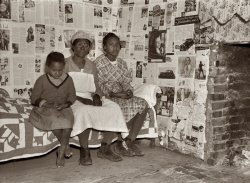
- Broke, Baby Sick: 1937
- ... baby sick, car trouble." Photo by Dorothea Lange for the Farm Security Administration. View full size.
I hope I hope that the baby ... Posted by Dave - 06/12/2013 - 9:19pm -
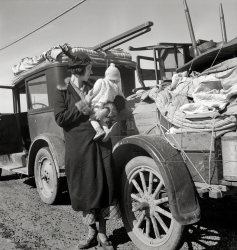
- Big Four: 1940
- ... Four Cafe." 35mm nitrate negative by John Vachon for the Farm Security Administration. View full size.
Big Four The cafe was ... Posted by Dave - 05/25/2012 - 7:58am -
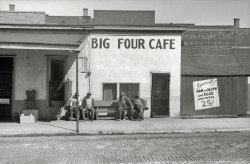
- Our Daily Bird: 1942
- ... . Medium format acetate negative by John Vachon for the Farm Security Administration. View full size.
Pin feathers and pin curls ... Posted by Dave - 02/16/2022 - 7:24pm -
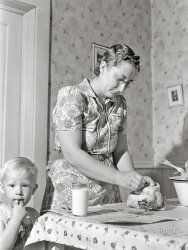
- The Hot Seat: 1939
- ... in Lamoille, Iowa." Photo by Arthur Rothstein for the Farm Security Administration. View full size.
Gives Appetite to All The ... Posted by Dave - 01/17/2018 - 6:46pm -
![The Hot Seat: 1939 October 1939. "Farmer sits near the stove. General store in Lamoille, Iowa." Photo by Arthur Rothstein for the Farm Security Administration. View full size.
Gives Appetite to AllThe healthy baking powder.
Brands you can buy todayClabber Girl
Copenhagen
Dr. Pepper
Kellog's All-Bran
Kotex
Pepsi
Modess
Wheaties
Maca YeastA new fast dry yeast.
ModessFrom a 1928 Ladies Home Journal:
“In order that Modess may be obtained in a crowded store without embarrassment or discussion, Johnson & Johnson devised the Silent Purchase Coupon presented below. Simply cut it out and hand it to the sales person. You will receive one box of Modess. Could anything be easier?”
More here:
https://www.kilmerhouse.com/2008/02/the-product-that-dared-not-speak-its...
[Or you can stock it next to the Wheaties, and hope for the best. - Dave]
Brands You Can Buy Today, Vol. 2Don't forget Kix, between the All-Bran and the Heinz product du jour, and of course Ivory Soap, proudly displaying its uncanny ability to float to the top.
LOOK!The hands of that farmer speak volumes!
Dowagiac Round OakThe Round Oak stove that dominates the photograph was the product of a company that only had a few more years to live. The Estate of P.D. Beckwith, Inc. produced wood stoves in their hometown of Dowagiac, Michigan from 1871 to 1946 or '47, when they sold the buildings to Kaiser-Frazer automobiles and the Round Oak name to Peerless Furnace. Founder Philo Beckwith died in 1889, and the company name was officially changed from Round Oak Stove Company to The Estate of P.D. Beckwith, Inc. about 1890.
Round Oak stoves were quite efficient for their time and very popular, and at one point employed more than 20% of Dowagiac's population.
Farms consolidateSurprisingly, Iowa was the 10th most populous state in the 1900 census. As farms consolidated in size and as cities grew, it slid down the rankings every decade since then. In 1940 (a year after this photo) it was the 20th most populated; today it is about the 30th.
Not just Round Oak... but quarter-sawn, as well. Wonderful chair he's sitting in!
My local Potbelly Sandwich Shop has the same stoveOr most of it. Some of the parts are missing. My wife and I lived at Lincoln and Armitage in Chicago in the 1980s and used to go to the original (pre-franchise) Potbelly restaurant, which is still in business there.
Pepsi-Cola hits the spot... 12 full ounces, that's a lot! Or you could have Dr Pepper at 10, 2 and 4!
"Modess--Because"This was how this product was discreetly advertised in women's magazines back in the 1950s-early 1960s. It was the caption to a photo of a beautiful woman, dressed in an elegant ballgown, usually standing on a mansion terrace overlooking the French Riviera at night. At age 5, I didn't know what Modess was, but when I grew up, I wanted to be that lady!
(The Gallery, Arthur Rothstein, Small Towns, Stores & Markets)](https://www.shorpy.com/files/images/SHORPY-8b19034a.thumbnail.jpg)
- Meet the McRaiths: 1942
- ... Fanny McRaith - and his brother Pat had managed the main farm owned by their parents and located in Meeker County. But "two years later ... the primary goal here. John Vachon's photos for the Farm Security Administration and Office of War Information are all online , ... Posted by Dave - 08/14/2021 - 6:22pm -
![Meet the McRaiths: 1942 February 1942. "Meeker County, Minnesota. Mike McRaith and family. He farms eighty acres." Acetate negative by John Vachon for the Office of War Information. View full size.
Mind over MaterI just love the expression on Mom's face there. She looks mortified for some reason.
I'd rather have a bottle in front of me than ...Looks like Junior is just propped up against the furniture recovering from his frontal lobotomy.
The Wright name of the countyRobert Ried Reid, the author of "Picturing Minnesota: 1936-1943" (1989), interviewed Mike McRaith and his relatives in the late 1980s when writing the chapter of the book dedicated to the Vachon pictures of the McRaith family farms. He explained that Mike - one of ten children of Jerry and Fanny McRaith - and his brother Pat had managed the main farm owned by their parents and located in Meeker County. But "two years later Mike married and bought a 75-acre farm in Wright County near Montrose, some thirty-five miles from the McRaith farms." A footnote, citing a 1987 interview with John McRaith, explained that "the photographs of Mike and his family were taken near Montrose in Wright County, as indicated in the corrected captions."
https://www.google.com/books/edition/Picturing_Minnesota_1936_1943/IqPjx...
The "corrected captions" are apparently not on the Library of Congress versions of the photos.
WIsh we knew the backstory of these photographsI don't mean the history of the subjects themselves - the Shorpy community are a crackerjack corps of researchers.
What I'd like to know -
How did Vachon (and others) get these folks to sit for portraits? This one shows a respectable setting, but some of them show the subjects in settings which a proud person might well not choose to be portrayed to the world.
What did they tell the people about how to pose? This one frankly has some strange poses and expressions.
How did they decide which negatives to publish? It sure would be interesting to see the (probably lost forever) outtakes.
[Documentation, not publication, was the primary goal here. John Vachon's photos for the Farm Security Administration and Office of War Information are all online, including the dozens of pictures he took of the McRaiths. - Dave]
Twins?The two boys appear to be the same age; I'm guessing they're fraternal twins. The one sitting on the floor has been subdued, likely by his mother. The one on the tricycle has both his mother's worried attention and his father's hands poised to stop any sudden movements. "Please Mr. Vachon. Hurry up and take the picture!"
(The Gallery, Agriculture, John Vachon, Kids)](https://www.shorpy.com/files/images/SHORPY-8c20883a.thumbnail.jpg)
- Thirst Trap: 1940
- ... New Mexico." Medium format negative by Russell Lee for the Farm Security Administration. View full size.
Square Fronts- Mogollon, New ... Posted by Dave - 07/30/2018 - 8:18pm -
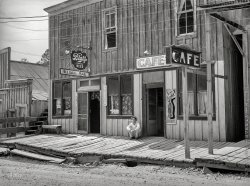
- The Old Paxton Place: 1938
- ... Medium format acetate negative by John Vachon for the Farm Security Administration. View full size.
2556 Douglas Street I can't ... Posted by Dave - 08/08/2020 - 6:44pm -
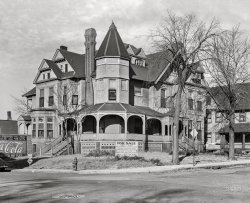
- Progressive Farmer: 1939
- ... post. 35mm nitrate negative by Russell Lee for the Farm Security Administration. View full size.
Conservation was the game ... Posted by Dave - 06/24/2012 - 9:50pm -
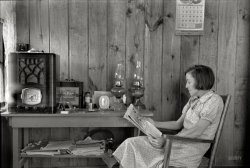
- Ninth Street: 1940
- ... full size. 35mm nitrate negative by John Vachon for the Farm Security Administration.
Quiet Street Scenes I love quiet street views ... Posted by Dave - 09/11/2011 - 10:39am -
![Ninth Street: 1940 May 1940. "Residential street in Woodbine, Iowa." View full size. 35mm nitrate negative by John Vachon for the Farm Security Administration.
Quiet Street ScenesI love quiet street views like this and also the city shot that is next. It places you as a pedestrian on the same street. This shot has a calm old-fashioned quality I really like, and I appreciate the chance to see an "average" street where people like my grandparents lived their lives.
WoodbineNinth Street is not very long. This might be at Ely Street. It's hard to read the sign turned away from the camera. The Ninth Street sign is a great example of button copy, where smaller round reflectors would be fitted inside the white text. US 30 passes through town. Lincoln Street is likely the original Lincoln Highway. Nowadays the utility pole and signs would be behind the curb. I'm not sure what to make of that sidewalk.
Ninth Street House for SaleAccording to Zillow there's a house for sale on Ninth Street in Woodbine for $57,000. That's a bargain by Connecticut standards except it's for sale by HUD suggesting it's a foreclosure situation with the house being in unknown condition.
Might be ElyI futzed with the levels and curves in Photoshop, but I don't have enough pixels. Can we get a zoom?
Odd, but the sun looks like it's coming from behind and to our left, which would make that direction South (if it's high noon), but 9th St. runs East-West. We don't know if the sign was just pushed and twisted a little or a lot. Google Earth's images of Woodbine are fairly good res.
[Look again. The lady is walking along Ely (or whatever) Street. Ninth is perpendicular to the shadow cast by the pole. The left edge of the Ely sign is closer than the right (the ST half is pointing away from us). - Dave]
Iowa HousesThis past summer my I had to go back to Iowa to sell my father's house. It was an absolutely charming craftsman (built in shelves & other wood details, original beveled glass in several windows & exterior doors, etc.), hip roof, porch), 2 bedroom, in fine shape and sold for $39K. The same house where I live now, Ithaca, NY, would be at least 150+ K more. It's possible to get a very nice house in Iowa for very little money.
901 ElyI can't make out the house number for the house on the corner, but it sure looks like this house that's for sale, at 901 Ely Street, Woodbine IA 51579, which is at the corner of Ely and Ninth.
http://www.zillow.com/Gallery.htm?zpid=2146016195
And when you go to Google Maps, you can see the faint outline of the diagonal sidewalk, from the house to the corner.
The house has a pending sale, listed at $24,900. A house with a little unknown history.
Sign in the YardDid you notice the small sign in the yard? Along the sidewalk, left of the tree trunk. Wonder what it says. Room for rent? Sewing? Laundry?](https://www.shorpy.com/files/images/8a05723u.thumbnail.jpg)
- Future Farmer: 1941
- ... Whitman County, Washington." Photo by Russell Lee for the Farm Security Administration. View full size.
Agro-Style! Well, I tell ... Posted by Dave - 02/25/2022 - 1:10pm -
